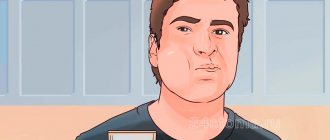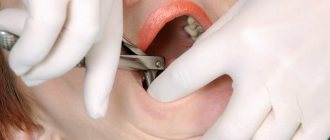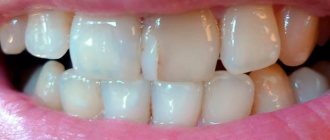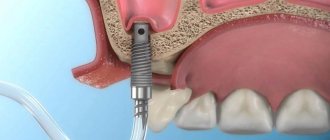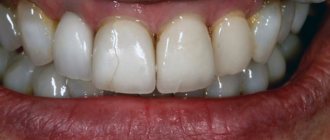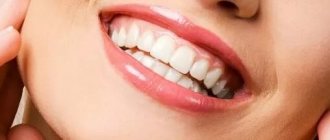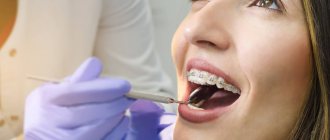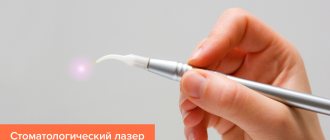Patients often experience fear before surgical treatment. This is completely natural and understandable. As a doctor, and simply as a person who also has to seek medical help, I completely share these feelings. That is why I want to talk in more detail about such a widespread procedure as the removal of third molars (wisdom teeth) in order to dispel a number of myths about this manipulation, and, I hope, help patients drive away unnecessary anxiety and properly tune in to treatment.
Removal of wisdom teeth due to caries
Why are wisdom teeth most often affected by caries?
Most often, caries of wisdom teeth develops due to the fact that they are located far enough away and do not participate in the act of chewing.
And if the teeth are not involved in the act of chewing, then it is extremely difficult to clean them due to the fact that the teeth are cleaned not only during hygiene, but also during each meal - on their own. On the picture
– what caries looks like on the bottom eight.
You can see how the lower wisdom tooth is removed due to caries HERE. By the way, there, in clinical cases, you can see how the removal of an upper wisdom tooth occurs.
Often the patients themselves neglect these teeth, brush the eights less carefully and caries develops quite quickly, the wisdom tooth begins to hurt, so it will be easier to remove such a tooth than to treat it.
Can caries cause wisdom tooth removal?
Should wisdom teeth with caries be removed? Yes. Removal of the figure eight, if there is caries, is carried out due to the inappropriateness of its treatment.
In most cases, we do not chew with these teeth, and treating wisdom teeth is quite difficult and problematic. And most importantly, this makes absolutely no sense.
Removing the bottom eight can be seen HERE
There is also a situation when the wisdom tooth is strongly inclined, “lying” and covered with caries. In this case, there is also absolutely no point in treating wisdom teeth.
.
If your wisdom tooth gets injured: chipped or cracked?
Should it be removed? A chip, crack, or injury to a wisdom tooth is a 100% indication for removal
wisdom tooth There is absolutely no reason to fight to save him.
Wisdom teeth during orthodontic treatment
Removal of wisdom teeth before orthodontic treatment
During the period of orthodontic treatment, when the bite is being corrected, the figure eights are also most often removed. Why?
Before orthodontic treatment, we need to remove teeth that are preventing all the remaining teeth - 28 teeth - from moving into place. As a rule, wisdom teeth do not provide freedom for such activities. We remove them and then perform orthodontic treatment.
In what cases are wisdom teeth not removed during orthodontic treatment?
In the case of large jaws, when the wisdom teeth are in an absolute row and they close correctly, in the correct occlusion, we do not need to remove them. We can leave them, we can also treat them, take care of them, like other teeth.
Awareness/lack of awareness of the process
It is important to find out in a preliminary conversation what type a particular person belongs to. Some people feel calm, knowing in detail what will be done to them, while others are only more alarmed by the details, and they prefer to abstract themselves from the process as much as possible, believing in “magic,” if you will.
You can compare these reactions with the experiences of passengers during air travel. Some people feel calm until they know all the processes in aircraft systems. And others suffer from aerophobia, and they are helped by various information materials that cover the details of the work. At the same time, for the first category, such knowledge can be dangerous and destroy their peace of mind and faith in the divinity and reliability of air transportation.
Impacted and dystopic wisdom teeth
Impacted wisdom tooth
- this is a tooth that has not erupted; it is located in the bone tissue, in the gum. The general practice is that few dentists decide to remove an impacted figure eight, since it is a complex procedure.
In the clinics of the German Implantology Center, removal of impacted wisdom teeth is carried out as planned; our experience allows us to perform surgery of this level.
Why don't wisdom teeth erupt?
The wisdom tooth does not erupt due to the fact that it is dystopic: there is a neighboring tooth in front of it, which is in the way.
This wisdom tooth is usually tilted. Or there is absolutely no room in the jaw, it is located at the corner of the jaw: there is no place for it to cut through, there is no way.
Dystopic tooth
A wisdom tooth is a tooth that is erupting or has erupted incorrectly. Or it cannot erupt and occupies the wrong position in the jaw.
Typically, such teeth displace other teeth, deforming the jaw. It is impossible to treat them, and straightening them is also extremely difficult. In these cases, we remove the dystopic wisdom tooth. As a result of dystopia, cheek injuries may also occur due to chronic biting. Therefore, it is better not to postpone the removal of the dystopic eight “for later”.
Smells
What smell do neither patients nor doctors like? These are negative smells. The aroma of burnt bone, pus, unwashed body. Aggressive odors of drugs (including alcohol).
In addition, the same scent of perfume can be pleasant to some and disgusting to others.
The solution is simple - the clinic should be as neutral as possible. It is necessary to avoid obsessive smells of perfumes and air fresheners in the halls. Perhaps the smell of freshly brewed coffee is one of those few smells that is favorably received by the maximum number of people, and this smell creates comfort in the clinic lobby.
Removal of wisdom teeth in pregnant and lactating women
Removal of wisdom teeth in pregnant and nursing mothers
Is it possible to remove wisdom teeth during pregnancy? Pregnant and lactating women can have their wisdom teeth removed only in case of exacerbation of one of them or necessity, when it is impossible to solve this problem conservatively. In a planned manner, it is better to remove wisdom teeth after the end of the feeding period.
Are there any special features of removing wisdom teeth during pregnancy?
We try to perform tooth extraction on all our patients as carefully, comfortably, and carefully as possible. Therefore, as a rule, there are no technical features. But if any intervention in the form of wisdom tooth removal is urgently required (because there is no other alternative), we must consult with the attending physician - a gynecologist and, accordingly, coordinate all our actions.
What anesthesia is used when removing wisdom teeth in pregnant and lactating women?
In pregnant and lactating women, after consultation with a gynecologist, we, as a rule, perform anesthesia with a reduced level of adrenaline, so as not to provoke the onset of labor in the later stages, and not to provoke a miscarriage in the early stages.
Types of anesthetics
Removal of a molar tooth with an injection involves several types of pain relief; the choice is made by the doctor, depending on the location of the molar, the degree of tissue destruction, the expected time of extraction and other factors:
- Applique. This type of anesthesia is used mainly if the patient is afraid of pain from the injection of an injectable anesthetic, as well as when tartar or baby teeth are removed from a child. A special gel or spray is applied to the gum area near the molar.
- Infiltration. This type of anesthesia involves two injections of a substance, from the side of the palate and the lip, the medicine is injected into the apex of the root through the gum. Freezing begins within two minutes after the injections and lasts for another hour after the end of the extraction procedure. Infiltration anesthesia is good because the patient does not feel pain, and there is no numbness in most of the face.
- Conductor. Such anesthesia is necessary when removing wisdom teeth and molars. An injection is made in the area of the trigeminal nerve, as a result of which the sensitivity of a large part of the face is blocked, and numbness persists after extraction for another 1.5–2 hours.
- Intraligamentary. The patient receives an injection into the periodontal fissure, it is carried out under more powerful pressure. The medicinal substance is located inside the bone tissue of the alveolar process, due to which the effect occurs instantly, but lasts about 30 minutes.
- Stem. This type of anesthesia involves serious maxillary surgical interventions; the branches of the maxillary and mandibular nerves are blocked. The injection is injected into the lower edge of the cheekbone, a pronounced freezing effect begins after 10 minutes.
- Sedation. With this type of anesthesia, the patient is depressed or asleep (with deep sedation). The superficial type of such anesthesia allows a person to respond to the doctor’s voice and follow his commands, swallow saliva, open his mouth, while the patient is relaxed and does not feel any discomfort. The medicine is administered through a mask or injected into a vein.
In especially severe cases, when extensive surgery is required, the patient is allergic to other types of anesthesia, or is simply panicky about the extraction procedure, doctors use general anesthesia. However, this method is used extremely rarely, since general anesthesia requires intervention in a hospital setting and under the strict supervision of an anesthesiologist.
At the same time, the medicine remains sterile, it does not need to be opened, and it does not come into contact with air when drawn into a syringe. The thinnest needle ensures minimal discomfort when administering the drug. The following modern anesthetics are used for extraction:
- Articaine is an anesthetic drug that is used in conduction and infiltration anesthesia, when it is necessary to remove several molars in a row;
- Scandonest is a drug contraindicated in adolescents under 15 years of age and elderly patients, as well as people with diabetes, kidney, liver and heart diseases;
- Septanset is a medicine that contains an anesthetic and adrenaline, it is used for the removal of molars, long-term treatment and when cleaning the roots of teeth.
Modern drugs rarely cause allergies, but if a person has a predisposition, he should definitely notify the dentist about this in order to avoid unforeseen situations.
Removal of a wisdom tooth near the maxillary sinus
If the wisdom tooth is located near the maxillary sinuses, there is a certain difficulty in such removal. Why?
If a wisdom tooth is located close to the maxillary sinus, there is a risk that during removal the tooth can be pushed into the maxillary sinus. If you make incorrect technical movements when removing a tooth, or work roughly in some way, you can harm the person and, accordingly, you will then need expensive long-term treatment to remove this tooth.
Are there any specifics to removing wisdom teeth?
Of course, there are some peculiarities when removing wisdom teeth. The doctor’s task is to make the removal process as accurate as possible, as atraumatic as possible - in principle, like the rest of the teeth. But in the case of a wisdom tooth, there are some peculiarities of anatomy.
The peculiarities are that the figure-eight tooth is located quite far away and quite well hidden. But at the same time, using modern equipment, modern materials and having experience, you can remove wisdom teeth quickly and accurately enough without consequences or injuries.
Sound background
In modern dentistry, it has become a practice that during a dental appointment, classical or calm music should be played in the office to calm the patient. But there is a misconception here. Not all patients like this type of music. The fact is that real people with their own preferences come to see us. Some people like Rock, others Rap, Folk, Punk, “Red Mold”, “Gas Sector”, Soviet pop music, etc. It is better to clarify your preferences before manipulation.
In one of his lectures, Alexey Vodovozov mentioned a study that found that during surgical procedures, the music that the surgeon likes is most effective. It reduces errors and complications, increasing concentration and quality of results.
In my opinion, it is best to reach a compromise here and choose the background that suits all participants in the process. It so happened that in my practice Rammstein often sounds. And even ladies of advanced age listen with pleasure. And at subsequent receptions they themselves ask to stage “that energetic German ensemble.”
Competent removal of wisdom teeth
How to remove a wisdom tooth in the least traumatic way?
The wisdom tooth is removed atraumatically after carefully evaluating the computed tomography scan, talking with the patient, and assessing his clinical case. The tooth is separated - divided into parts if it has any bends, slopes, or several roots. And, accordingly, with the help of elevators, luxators - special dental instruments, it is carefully and carefully dislocated.
There is no need to worry about the appearance of some blood after wisdom tooth removal. The removal is carried out under the full supervision of a doctor; the wound after tooth extraction is sutured and sutures are applied. What follows is a standard rehabilitation protocol without any surprises for the patient. The only thing is that after the removal of a wisdom tooth (wisdom teeth), swelling of the mucous membrane is possible.
Why is atraumatic tooth extraction more preferable?
With this removal, the doctor takes care of the health of the patients. So that the healing takes place as comfortably as possible, so that there are no consequences after this, so that the patient in the near future, after 7-10 days, forgets that he had his wisdom tooth removed. It is after this time that possible swelling and pain after removal are completely removed.
Pain after wisdom teeth removal
How long does pain last after wisdom tooth removal?
Pain after the removal of wisdom teeth lasts differently, depending on the sensitivity of the person and how the healing proceeds in general. It hurts after removing the figure eight from several days to, maximum, 7-10 days. Naturally, all pain, all painful symptoms from wisdom tooth removal subside over time.
What should you do if the wound hurts for a long time after wisdom tooth removal?
If you experience prolonged pain after wisdom tooth removal, you should contact your doctor as soon as possible, and he will adjust his prescriptions. If any problems arise, he will solve them.
When should wisdom teeth not be removed?
What can serve as a contraindication to wisdom tooth removal? A contraindication to wisdom tooth removal may be a person’s health condition, as a result of which we cannot subject him to such a surgical intervention.
For example, if the patient suffers a heart attack in the near future, within six months. Or he has some kind of uncompensated disease. In these cases, we first prepare the patient, consult with related specialists, and after that, as planned, we carry out removal procedures.
Complications after wisdom tooth removal
What may be the cause of complications after removal of figure eights?
Complications after removing the figure eight - yes, they exist. Complications are different: they occur directly during the removal procedure, there are delayed ones, blood vessels may be damaged, and bleeding may occur. There may be a fracture of the jaw, a breakage of a section of bone tissue that is located in close proximity to the wisdom tooth.
Long-term complications – for example, wound infection in the case of unsterile instruments. If the doctor did not warn the patient that he needs to take antibiotics prophylactically for an impacted wisdom tooth.
What are the complications after wisdom tooth removal?
After the removal of a wisdom tooth, there are complications of different etiologies: they can either arise immediately or be delayed. Bleeding may immediately occur, your jaw may break, a piece of bone may break off (both small and large) - then your jaw will begin to hurt. You can tear the mucous membrane, injure a neighboring tooth, break a neighboring tooth, etc. Your gums or throat may begin to hurt.
Delayed complications are oral infection, periostitis, alveolitis, inflammation of bone tissue.
Can the temperature rise after wisdom tooth removal?
After the removal of a wisdom tooth, the temperature may rise in people who are very nervous or have suffered a lot of stress. This will be a vegetative-vascular reaction, and once the temperature can rise to 38.5-39 degrees. Once. It can be brought down by the use of antipyretic drugs and, accordingly, it should no longer be present. There may be a low-grade fever of 37 degrees, 37.1-37.2, for several days after removal. This does not have any consequences, this is normal, but you should, of course, inform the doctor about this so that he takes this fact into account and adjusts his prescriptions.
Can gumboil appear after wisdom tooth removal?
After wisdom tooth removal, gumboil may appear. This can happen as a result of a wound becoming infected. For example, the use of non-sterile instruments, non-sterile materials. This can also be a result of the removal of an impacted wisdom tooth, for example, if the doctor “sutured it in tightly”, and there are a lot of bacteria in our oral cavity, and did not prescribe antibiotic prophylaxis. In this case, flux is likely to occur.
Leadership and Communication
As I said, patients are living people. And many who come to us are leaders who are accustomed to the fact that they decide, and not for them. The doctor’s task is to remain a leader within the office. A different situation can be disastrous for the patient himself. My favorite example is the cartoon “The Greedy Rich Man,” about what happens when a professional follows the lead of the customer. The doctor's job is to let the patient know that he knows what he is doing and the patient is in good hands. By the way, competent irony can relieve tension.
Physicians themselves must exude calm and reliability, both verbally and non-verbally. Calmness, friendliness, warm look, smile. Any gestures and touches towards the patient should be smooth and confident. Without unnecessary movements, fuss. It is good if all the necessary tools are prepared in advance, and dialogues between the doctor and the assistant are minimized or absent altogether. An interesting fact is that the measured chatter between the doctor and the assistant on abstract topics during surgery makes some patients distract themselves from their worries and “prick up their ears” in anticipation of the “story.”
Dry socket syndrome during wisdom teeth removal
Dry socket syndrome in wisdom teeth
The wisdom tooth refers to the concept of dry socket, or more precisely, dry socket syndrome. A dry tooth socket is alveolitis. Dry socket syndrome after the removal of figure eights can occur in this area, especially in the area of the lower wisdom teeth due to the fact that as a result of swallowing, as a result of opening the mouth, muscles tense, which aggravate the occurrence of alveolitis.
What can dry socket syndrome lead to and what to do?
A dry socket after the removal of figure eights can lead to very severe pain that radiates to the temple and ear. This is a very great torment: a person cannot, even if he is not sensitive, he cannot tolerate it, he will definitely take painkillers 4-5 or 6 tablets. And as a result of this, he will still go to the dentist. A dry socket, if it has formed after removal, will not go away on its own. Alveolitis can only get worse - up to inflammation of the jaw. There may be dire consequences.
Recommendations after wisdom tooth removal
What medications should you take after wisdom tooth removal?
The following medications are used after wisdom tooth removal: painkillers, mouth rinses - special, with a strong antiseptic content. Often, an antibiotic is prescribed as therapy after the removal of the figure eight, and we also prescribe probiotics to restore the intestines after taking antibiotics.
Recommendations after wisdom teeth removal
In general, the recommendations are the same as in the case of removing simple teeth. But they should be performed more carefully.
Physical exercise
–
exclude
. Try not to disturb the extraction site, because the wisdom tooth is located in an awkward/unfortunate area where swallowing and opening the mouth will affect the surgical site.
Of course, wisdom tooth removal is incompatible with subsequent alcohol consumption for several days. Smoking is also strictly not recommended.
Brushing your teeth after wisdom tooth removal
Is it necessary to brush your teeth after wisdom tooth removal or can you wait a few days? You should definitely brush your teeth after removing a wisdom tooth. This needs to be done quite carefully, but at the same time carefully. It is not recommended to rinse your mouth after wisdom tooth removal. That is, the question “what to rinse your mouth with” in this case disappears. Using an irrigator is also not recommended.
Opinion about the pain and duration of the procedure
Many patients have already heard from their friends or available sources of information that it takes 3 hours for wisdom teeth to be removed, that they are hollowed out by hitting a hammer with a chisel, that the jaw is broken, etc. Those who are especially lucky have already experienced the delights of unsuccessful removal for themselves. And implants are generally screwed directly into the BONE!!!
This fear has a basis, because some surgeons still gouge out teeth with a hammer. And novice doctors can remove a tooth for 2-3-4 hours. If you are a doctor and recognize yourself in these lines, I recommend attending my course. If you are still the happy owner of a wisdom tooth (or have other reasons to visit the dentist), then I have some good news for you.
- Modern anesthesia based on Articaine (Septanest, Ubistezin, Ultracaine, Alfacaine, etc.), although it does not give as much joy as great-grandfather Cocaine, but firmly turns off sensitivity in the desired area. Its toxicity is low, and allergic reactions are practically absent.
- Due to the peculiarities of innervation in the lower jaw, anesthesia “turns off” half of the jaw, while in the upper jaw the effect is very limited. In both cases, failure to meet the patient's expectations can lead to anxiety.
- With the proper experience and equipment, the removal process (without taking into account the wait for anesthesia) takes from a few seconds (on the upper jaw) to 10-20 minutes (on the lower jaw). There are, of course, exceptions. But the most insidious tooth in rare cases is removed in no longer than 45 minutes.
- There is no need to hammer anything. Modern tools allow you to carefully cut out a tooth in a short time. The doctor can use either an elevating handpiece with special surgical burs or ultrasonic cutting equipment. The sensations in the first case are similar to caries treatment, in the second - to professional oral hygiene. I think you are familiar with both.
- If you strictly follow all the doctor’s recommendations and do not add any amateur activities, then healing should be quite comfortable. Be sure to tell your doctor about any drug allergies so that the prescribed medications do not cause harm.
- Speaking of implantation, there are no nerve endings in bone tissue, which means that working with it is no more painful than cutting hair or nails. You don't panic in the beauty salon, do you? Using sharp cutters, a bed is carefully formed to the desired configuration of the implant, and then the implant is inserted into it. All. The procedure takes about 10 minutes, including anesthesia and suturing.
Removing 2 wisdom teeth at the same time
Removal of two wisdom teeth from one side of the jaw. Pros and cons of this approach.
Two teeth at once on one side is a very good technique. In this case, we immediately remove two teeth and the healing process takes place only once. Accordingly, the pain also disappears once. The healing is in no way burdened by the fact that we remove two of them at once. It’s a good, even excellent approach, and that’s what we do in most cases if the patient doesn’t mind.
An example of removing two wisdom teeth at once - HERE
Pain after removal
Since molar removal is still a surgical operation, albeit on a small scale, complications sometimes arise after it, including bleeding, inflammation of the gums, and loss of sensitivity. If the extraction went without complications, slight pain may be observed for 2-3 days after the intervention. There is nothing wrong with this; cool compresses help relieve swelling of the tissues; they are applied for 10–15 minutes.
To make the healing process of the hole more comfortable, the patient should follow the following recommendations:
- do not eat food immediately after extraction for 2–3 hours;
- make cool compresses 3-4 times a day, applying them to the painful and swollen area;
- do not visit places where the air temperature is too high or low and, moreover, do not allow sudden temperature changes;
- do not rinse the mouth on the first day so that a blood clot forms at the bottom of the hole - it is necessary to protect the wound from infection;
- in the absence of swelling and fever, you can relieve pain by taking Analgin, Baralgin or Ketorol tablets;
- give preference to soft food in the first two days after extraction;
- Do not drink carbonated drinks, spicy and sour foods.
If acute pain is accompanied by a rise in temperature and a sharp deterioration in well-being, you should not delay a second visit to the doctor - most likely, an infection has entered the hole or a small fragment of a tooth root remains there. Only a dentist can determine the cause of the ailment and solve the problem. The intensity of pain during extraction is the result not only of the anesthetic used, but also of the psychological state of the patient himself.
A problem-free procedure also depends on which teeth are being removed, whether there is an inflammatory process in the oral cavity, and whether the roots are large and thick. But in most cases, patients who were initially terrified of having their molars pulled out say goodbye to this problem forever, since modern dentistry allows extraction to be carried out absolutely painlessly and comfortably for the person.
Category: Tooth extraction Published by Mister stomatolog
Implantation in the wisdom teeth area
Is implantation performed in the area of wisdom teeth?
In the area of wisdom teeth, implantation is not performed in any cases. Due to the fact that there is no space in the jaw to install implants in this area. And, if we look at the jaw, it opens more in the anterior section, and in the posterior section it opens least. If we place an implant, we will not be able to make a normal-sized crown and, accordingly, use these implants for chewing.
During implantation, in case of bone tissue deficiency, the tubercle of the upper jaw or the retromolar space in the lower jaw is used to fix the outermost implants. If there is an impacted eighth tooth in this area, it is removed regardless of the complexity of the operation, since it interferes with the installation of the implant.
Cost of wisdom teeth removal in Moscow
The price of removing one wisdom tooth in Moscow clinics, if we talk about low-traumatic removal of both lower and upper wisdom teeth, can start from a price of 15 thousand rubles
and higher. The fact is that when removing a figure eight, the cost of bone material, which is used for small bone grafting, can be added to the price of the removal itself, since after removing a deep-lying figure eight, a void may form, which, you see, needs to be eliminated due to fears of the development of atrophy bones in this area.
But many doctors, both in Moscow and in the regions, neglect bone grafting and simply suturing the wound, thereby reducing the cost of wisdom tooth removal to 8-10 thousand. The choice of price always remains with the patient, but the patient also needs to evaluate the risks of such removal, look a little into the future and understand that saving 5-10 thousand rubles at this step may result in future problems with the 6th and 7th chewing teeth ... But this is a completely different story.
Visual background
The patient does not really understand the difference between an installation for 2 million and for 200 thousand. But he immediately sees the untidiness. Dirty floor, shabby, protruding wires, dripping faucet, sparking wiring, dried blood stains (including on the clothes of doctors) and a broken window.
Excessive pretentiousness both in the interior and in the appearance of health workers can also increase anxiety - “Am I overpaying for all this tinsel?”
The most optimal is a neat, clean office with a minimum of visual noise. With neat, tidy employees (but no frills). Such a visual background usually coincides with the patient’s expectations and allows him to relax a little before the upcoming torture.
During the appointment, it is also recommended to use darkened glasses (reduce anxiety) or virtual reality glasses with headphones (distract from the ongoing manipulations, which has a beneficial effect on the course of the procedure).
